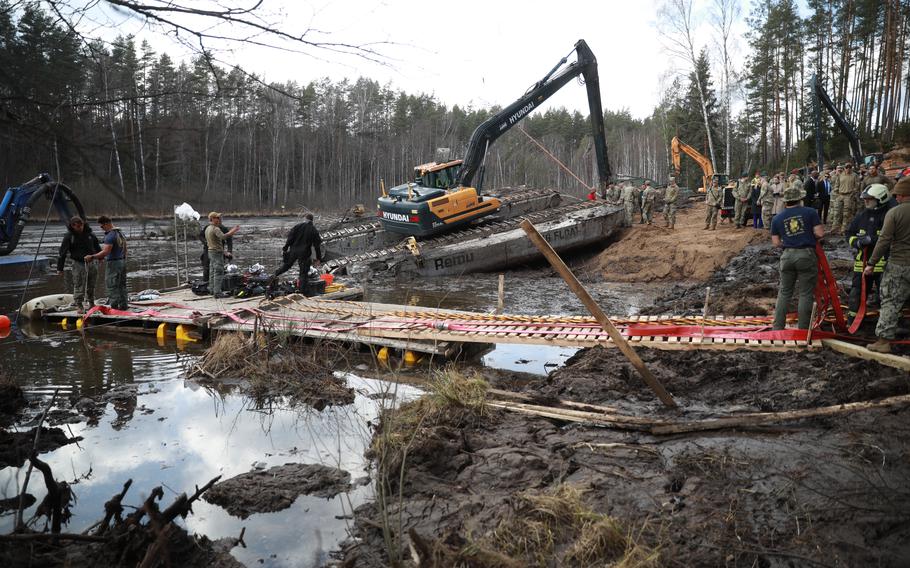
The dive team prepares a floating platform before entering the water. (Trevor Wilson/70th Mobile Public Affairs Detachment, U.S. Army)
The search party fanned out to scout for any sign of four American soldiers — and their 70-ton vehicle — who last month vanished in the night deep in the woods outside Pabrade, near Lithuania’s border with Belarus.
It was 1st Sgt. Matthew Riley who discovered the tread marks that had gouged the soft earth along a firebreak trail. They led to a wet patch, barely 30 feet in diameter, but did not continue on the other side. Afloat on the surface was a soldier’s satchel and a bottle of weapons lubricant.
There was a strong smell of fuel, but those who eyed the bog were skeptical something that small could swallow such a massive armored vehicle. A soldier waded in to their waist, but Riley was adamant: Someone had to dive down into the muck and be sure.
Over the next seven days, scores of people from four countries plumbed the muddy bog to locate and recover the missing men. The mission, fraught with extreme environmental and engineering challenges, was animated by risk and ingenuity — and a guiding belief in the military imperative that everyone must go home.
“We weren’t leaving without our boys,” Senior Chief Master Diver Carlos Hernandez, who led the U.S. Navy dive team on site, told The Washington Post.
This account is based on interviews with more than a dozen individuals either involved with the operation or who knew the four soldiers who died in the March 25 tragedy: Staff Sgt. Jose Dueñez Jr., 25; Staff Sgt. Edvin F. Franco, 25; Pfc. Dante D. Taitano, 21; and Staff Sgt. Troy S. Knutson-Collins, 28. Efforts to speak with their families were unsuccessful.
An investigation is underway to determine how the crew was lost, with a separate inquiry focused on safety takeaways, said Maj. Gen. Curtis Taylor, the commander of the 1st Armored Division who led the recovery effort. A part of the investigation, Taylor said, will focus on whether it was appropriate for the soldiers to be sent into the woods by themselves. Georgia Franco, whose husband was among those killed, told CBS News she has demanded answers about that decision.
“They were never supposed to be out there alone,” Franco told the network.
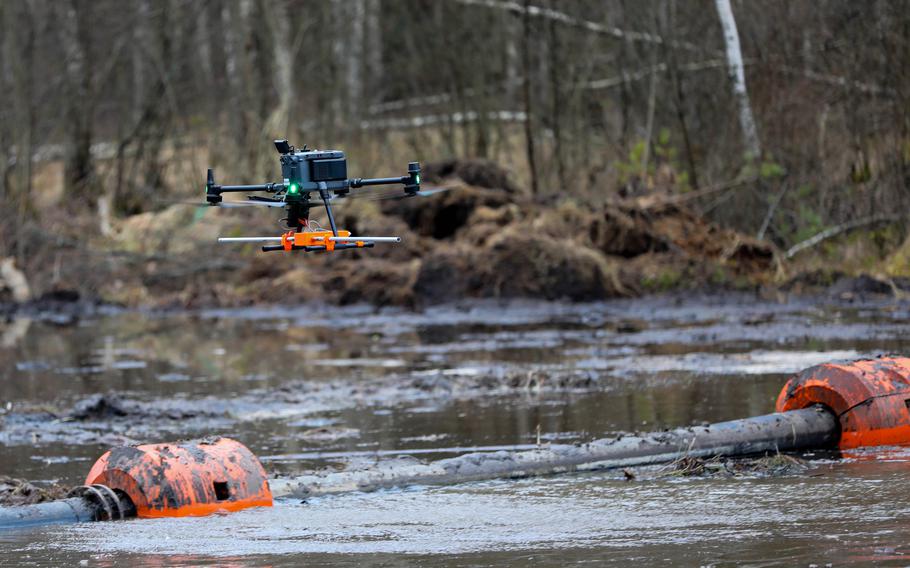
A drone with ground-penetrating radar scans the bog. (Rose Di Trolio/70th Mobile Public Affairs Detachment, U.S. Army)
The recovery
There are roughly 80,000 U.S. troops across Europe, and following Russia’s invasion of Ukraine in 2014 and its expanded war that began in 2022, training among NATO allies has intensified. Few countries are concerned more about Russian aggression than Lithuania, a small Baltic country bordering Moscow’s ally Belarus. About 2,000 U.S. personnel are stationed there on rotational deployments.
Since February, that mission has belonged to 1st Armored Brigade, 3rd Infantry Division. A cornerstone of these deployments is training at the military reservation near Pabrade, a vast tract of rolling hills, wetlands and dense forests, not unlike their stomping grounds back home at Fort Stewart in eastern Georgia.
An artillery unit in the brigade had settled into nighttime training with its howitzers when a tactical vehicle became mired in the mud. The job to haul it out was tasked to Dueñez, Franco and Taitano, who were Abrams tank maintainers versed in retrieving disabled vehicles. All three had trained to recover vehicles at night, and this presented a valuable real-world opportunity to further hone those skills.
They climbed inside their M88A2 Hercules, an armored behemoth itself built on a tank chassis with a heavy towing system, and set out through the forest. With them was Knutson-Collins, an artillery mechanic in the brigade, helping to guide the crew.
Their trek in the early morning hours was slow going, with the heavy M88A2 capable of reaching a speed of around 25-30 mph. When radio contact with the crew was lost, a search effort was initiated that led to the muddy peat bog discovered by Riley.
A team of six Lithuanian divers was dispatched to the site, and what the divers found alarmed them. The bog, innocuous looking from level ground, churned with danger under the surface.
The wetland vegetation had partially decayed and, fed by a small pond nearby, created a thick morass of mud, sticks and grass. Its consistency made any movement exhausting, as if the divers were wading through drying concrete. They couldn’t see through their masks or get enough air through their regulators.
The Hercules, which can hold hundreds of gallons of fuel, had released significant amounts into the water, instantly degrading the divers’ equipment and limiting the time they could be submerged.
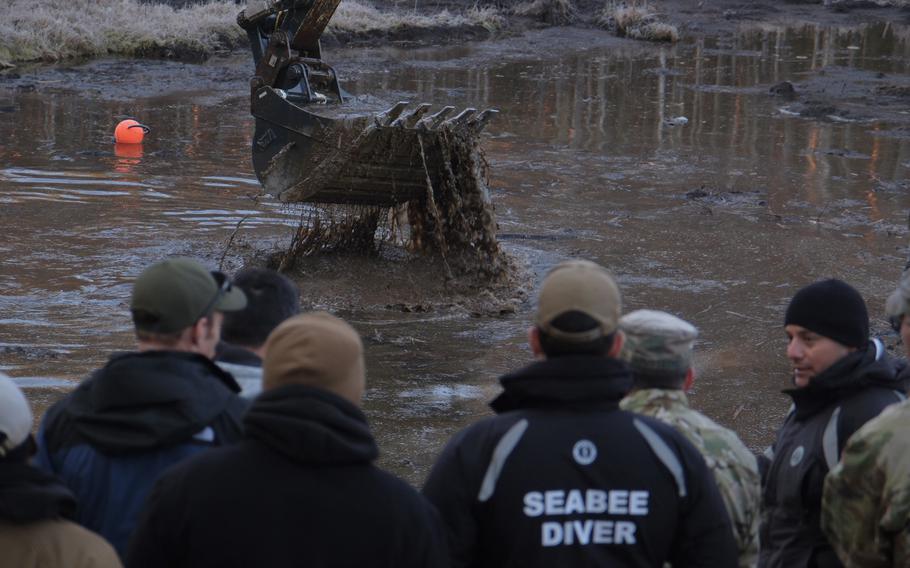
The bog, innocuous looking from level ground, churned with danger under the surface. (Christopher Saunders/70th Mobile Public Affairs Detachment, U.S. Army)
The divers made first contact with something steel around a depth of about 15 feet. Commanders on scene, worried it could have been some long-lost military vehicle or a farmer’s tractor, wanted to be certain it was the Hercules. The divers, having studied a similar vehicle in the motor pool, said they were confident that they touched the M88A2’s distinctive crane.
But problems were mounting. The vehicle, entombed in several feet of mud, was above a high-pressure gas pipeline but continued to sink, and fear quickly set in that any misstep could cause an explosion. Orders came down to clear the line.
Commanders assessed that the likelihood of recovering the soldiers would diminish the deeper the vehicle settled, so they turned their focus to thinning the mud. A field of gravel, 237 tons in all, was trucked in and spread out across the site to help stabilize the ground, and engineers felled nearby trees. Slurry pumps hummed around-the-clock.
A coffer dam was built over about 30 hours in what would prove to be a failed bid to drain the bog. Though officials estimated that as many as 700,000 gallons were pumped out, water kept seeping in from nearby.
Breakthroughs
The recovery team grew by the hour, eventually reaching hundreds of personnel. There were 250 U.S. service members, 160 Lithuanian soldiers and civilians, 50 Polish troops, and working dog teams from Estonia and Lithuania.
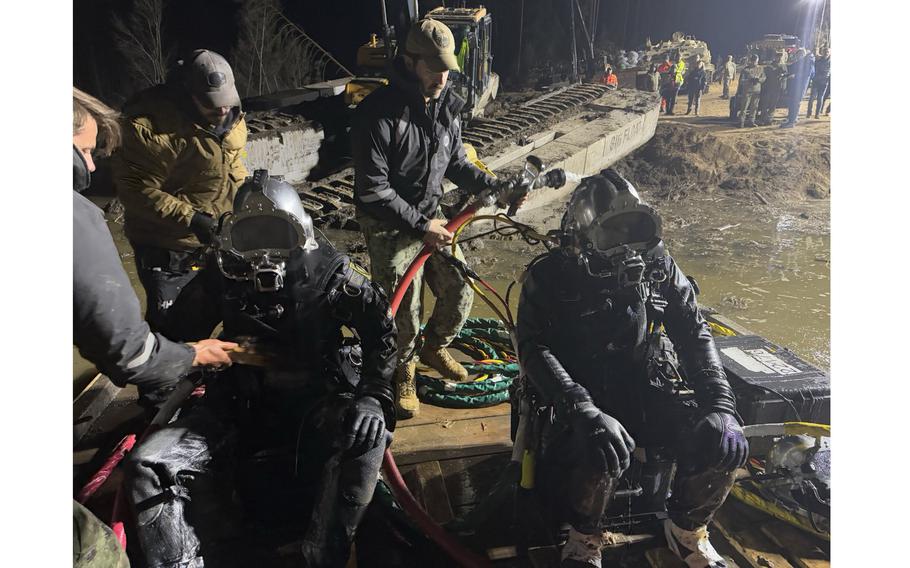
Construction Mechanic 2nd Class Steven Tausch, left, and Construction Mechanic 1st Class Ryan Filo after a dive. (U.S. Navy)
Some 2,000 miles away in Rota, Spain, a team of U.S. Navy divers received urgent orders to fly across the continent. When the sailors of Task Force 68 arrived for a briefing with their Lithuanian counterparts, they absorbed the gravity of the task. For some, it would be their first time working to recover human remains.
Their objective was to connect heavy cables to the Hercules’ tow points so it could be pulled from the bog. The divers would have to find their way to the submerged vehicle entirely by touch. To rehearse, they climbed over a spare vehicle, closing their eyes to learn its contours.
Once in the water, the divers used a fire hose to create a chimney in the mud through which they could swim and maneuver. It was an agonizing process. They struggled to kick through the sludge, and their arms approached muscle failure.
It took more than two hours to connect one cable to the tow point and then 15 minutes to tunnel themselves out again with the fire hose.
“We felt like the earth was reencasing around us,” said Construction Mechanic 2nd Class Steven Tausch, describing a subsequent dive to reach the Hercules’ second tow point. They surged water from the hose to push away mud from their helmets and bodies as they drew nearer.
At the surface, the team leader, Hernandez, anxiously awaited every update delivered by radio through labored breathing. The divers, though tethered to the surface, knew that in an emergency they may not be pulled from the bog in time.
“Everyone on the dive site was completely on edge,” Hernandez said.
It took 90 minutes for Tausch’s team to reach the second shackle point. The vehicle was secured.
“Get me … out of here,” Tausch said over the radio, using an expletive.
Two other M88s and two bulldozers were needed to pull the Hercules from the muck. Inside were the remains of three soldiers: Dueñez, Franco and Taitano.
The fourth, Knutson-Collins, was still missing.
Last man out
Back home in Battle Creek, Mich., Knutson-Collins’s family was feeling a mix of worry and optimism. He was a talented swimmer, they reasoned. Maybe he got out?
“I still want to be positive and hopeful that he’s somewhere else, still alive,” his father, Robert Collins, told local media.
A drone equipped with ground-penetrating radar was flown in to scan what lay concealed in the bog. It detected a helmet.
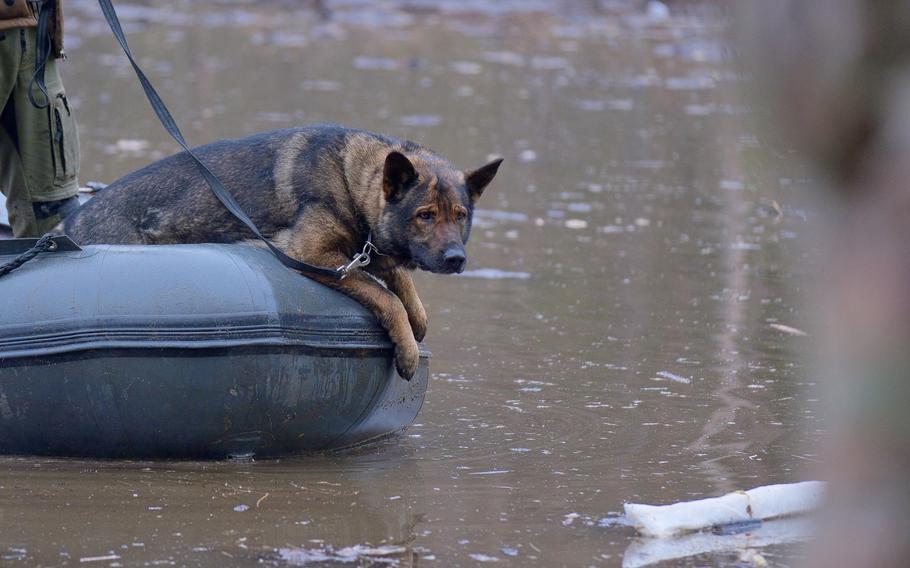
Maik was trained to bark when he found someone living or dead. (Christopher Saunders/70th Mobile Public Affairs Detachment, U.S. Army)
In the early morning hours of April 1, two search-and-rescue dog teams from Estonia’s Police and Border Guard Board arrived. The lead handler, Risto Kotkas, boarded a small inflatable boat with Maik, his 4-year-old German shepherd.
The wind had picked up, scattering the scent, and all the fuel in the water masked the odors Maik needed to track.
Maik was trained to bark when he found someone living or dead. He was not barking. Kotkas watched him carefully for any subtle body language — a tail wag, anxious energy or trying to lick the water’s surface. Kotkas and Maik orbited the bog until those signs converged, and the handler pointed out a spot to investigate.
Using an excavator, the recovery team gently dug down into the quagmire. Brig. Gen. John P. Lloyd, who as chief of the U.S. Army Corps of Engineers’ Atlantic Division oversaw the process, recalled spotting a pair of boots.
“I immediately knew that we had him,” Lloyd said.
The loss
Thousands gathered in Lithuania’s capital, Vilnius, on April 3 as a procession of hearses transported the soldiers’ remains for the first leg of their trip home. Among them was Lithuanian President Gitanas Nauseda, who tapped into the country’s painful past under Soviet occupation. “We have experienced trials in our history, and therefore we understand well what loss is, what death is, what honorable duty is,” he said in his remarks.
In a private moment, members of 5th Squadron, 7th Cavalry Regiment, the unit the dead soldiers were assigned to, huddled together and were silent for 10 minutes, said Capt. Madyson Wellens, the commander of the diesel forward support troop for the battalion.
Soldiers in the unit described profound loss.
Franco, a jokester from Glendale, Calif., stood out for his big smile and oversize glasses, said Sgt. Jeremiah Benetti. Wellens recalled that Franco spoke with admiration for his wife, who was home raising the couple’s infant by herself while he was deployed.
Dueñez, of Joliet, Ill., was a “duct tape and bubble gum” kind of guy, Riley said, explaining his innate gift for figuring out how to get nonfunctioning tanks running again. Dueñez volunteered for assignments more than any other soldier Riley’s ever known, he said, including the fateful mission to the peat bog, when he went to help even though he was not on the Hercules crew.
Knutson-Collins was similarly wired, said Staff Sgt. Caleb Cutting, a friend. They would talk and laugh about their kids, Cutting recalled, and it was evident he was eager get home to Georgia and see his family.
The youngest soldier in the group, Taitano, a native of Guam, was known for his twin passions: cooking Spam with rice and tinkering with his old Nissan pickup. He offered oil changes in the barracks parking lot, to the chagrin of the unit’s senior leaders who couldn’t help but be impressed with his acumen.
Pfc. Ephraim Adakwaah, who trained in vehicle recovery with Taitano, said the men’s deaths felt like losing family.
“It’s something that hurts on a deeper level,” he said.